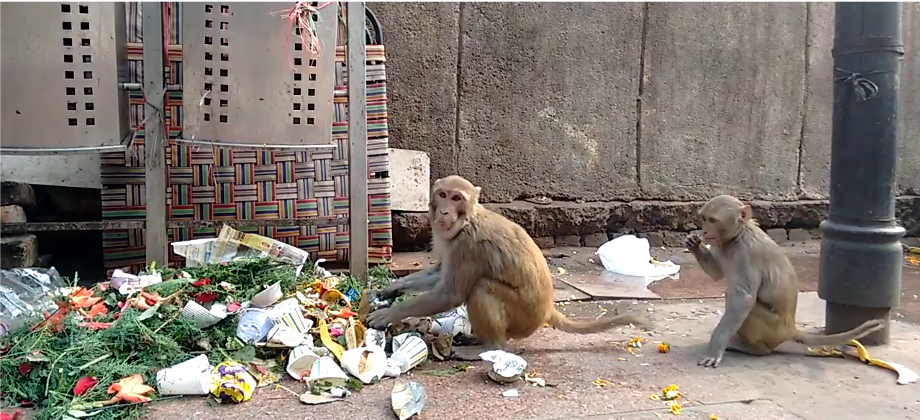Macaques, or monkeys as they are popularly known, have been synonymous in India from time immemorial. In stories, legends, and tales, monkeys abound, like the story of the intelligent monkey and the crocodile in the Panchatantra or the monkey king’s sacrifice in the Jataka tales. For many millennia, man and monkeys have co-existed in this region. The co-habitation scale is reflected in how we treat monkeys in our everyday lives, from reverence as a god to disdain as a pest. At one end, there are temples (dedicated to Hanuman) where the monkeys are revered, and on the other extreme, you have cases where monkeys are poisoned or brutally murdered.

As cities expand and gobble up the peripheral areas, these arboreal creatures have no option but to make do with living on the sidelines and adapting to the new reality. If foraging from trees is no longer possible, especially if you don’t have trees, would not survival drive these adaptable creatures to seek food in the garbage, shops, and homes? When humans invade their area and create boundaries, do we have the right to crib about the monkeys not adhering to our playbook. Another factor is that monkeys seem to like human co-habitation. Life is easier around human settlements as food abounds. Thus, you have more and more macaques preferring to live in an urban setting rather than the forest-dwelling. This is resulting in increasing man-monkey conflicts. The problem has grown so acute that even the Parliamentarians and the Supreme Court are involved in these issues, and orders are passed frequently on how to deal with the monkeys, from relocating them to forests to sterilizing them or even having humans dressed up as langur and imitating their calls to scare away the monkeys.
India is home to a large family of monkeys species distributed from the Himalayan North to the Oceniac South, from the lush forests in the Western Ghats to secluded forests in the North East. There’s hardly a region or place in India where you would not find monkeys. Yet, it is a misnomer that monkey populations are increasing, and they are not under threat. Numerous studies by the likes of primatologists like Anindya Sinha from the National Institute of Advanced Studies point out that the population of macaques has been declining or has been decimated in certain areas.
But to understand the challenges faced by the macaques, it is crucial to know who these beautiful creatures are. Here’s a quick list of interesting facts that talk about macaques.
There are approximately twenty-two species of Macaques that are principally found across Asia. (Barua & Sinha, 2020)
Macaques represent the most adaptable and evolutionarily successful of all nonhuman primates. (Barua & Sinha, 2020)
Bonnet macaques request food from humans with low-frequency vocalization, and minimal frequency modulation called a coo-call! (Deshpande, Gupta, Sinha, 2018)
Spirally arranged hairs on the top of the head create the impression of a hat, hence the name “Bonnet macaque.”
Macaques can survive 20 to 25 years in the wild and 30 to 35 years in captivity.
The Rhesus macaque is primarily found in the northern parts of India and the Bonnet macaque in the Southern parts of India.
Rhesus macaques are omnivorous animals, eating seeds, roots, bark, fruits, and cereals. But there have also been known to eat meat as well.
The young macaque doesn’t leave its mother until about one year old, by which time it has learned to forage independently.
Macaques are excellent swimmers.
Bonnet macaques sleep in trees, often preferring fig-trees, growing around human settlements.
A male Bonnet macaque is two times larger than a female.
Rhesus macaques can live in a range of climatic extremes, from hot, dry temperatures in deserts, to cold temperatures which fall in winter to far below freezing.
The Rhesus macaque has been an important experimental animal for medical and psychological research due to its relatively easy upkeep in captivity, wide availability, and closeness to humans anatomically and physiologically.
Rhesus macaques are noted for their tendency to move from rural to urban areas, relying on handouts or refuse from humans.
Bonnet macaques are highly social creatures who live in groups of 30 on average, consisting of multiple males and females.
Bonnet macaques are omnivores; they generally feed upon fruits, nuts, cereals, seeds, leaves, berries, flowers, and foliage, supplementing this diet with bird eggs and various invertebrates.
Bonnet macaques have a rather diverse diet, although their favorite food is a grasshopper.
As stated by the Indian Institute of Technology Madras, the four southern states of India hold about 170,000 Bonnet macaques.
Know more about these wonderful creatures from renowned primatologist Anindya Sinha as he sheds light on the behavioural traits and adaptation by Urban Macaques in India in a conversation with Shashwat DC. The talk will be aired live on Azim Premji University YouTube Channel.
Date: Friday, August 27, 2021
Time: 5 PM
Register (for free): bit.do/monkeyinthemirror
— Shashwat DC












Recent Comments